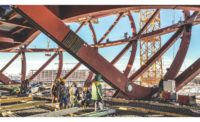AIA TAP Innovation Award Recipients Selected
Program Honors Projects that Highlight Collaboration Between Design and Construction Teams.

The American Institute of Architects (AIA) Technology in Architectural Practice (TAP) Knowledge Community has developed the AIA TAP Innovation Awards to honor state of the art of the design, delivery, and management of the built environment as enabled by advanced processes and technologies.
TAP has spearheaded efforts to highlight case studies from the profession in the harnessing of Building Information Model (BIM) technology and processes to further design, construction and project excellence. The AIA TAP Innovation Awards emphasizes how this array of new practices and technologies will further enable project delivery and enhance data-centric methodologies in the management of buildings for their entire lifecycle, from design, to construction and through operations. Categories for the TAP Innovation Awards include: Stellar Architecture, Delivery Process Excellence, Academic Program/Curriculum Development (none selected this year) and Exemplary use in a Small Firm.
The descriptions below give a brief summary of the projects being recognized. You can learn more about these projects by clicking on the name of the project/firm name. If you are interested in obtaining high resolution images, please contact Matt Tinder at mtinder@aia.org.
Category A | Stellar Architecture
Submissions in this category exhibit exemplary architectural design and display innovations in practices and technologies.
Emerson College; Los Angeles
Morphosis Architects
Morphosis created a custom computational tool to layout key design elements that allowed for aesthetic and sustainable features to be developed in concert with each other. Anticipated to achieve a LEED Gold rating, this project delivers advanced energy efficiency features including radiant heating and cooling, window contacts to facilitate natural ventilation, operable sunshades, user controllability, and solar thermal collectors. The project is expected to achieve a 15 percent energy cost savings over baseline figures and a 31 percent reduction of potable water use in all fixtures. Responding to local weather conditions, the automated sunshade system opens and closes horizontal fins outside the high-performance glass curtain-wall to minimize heat gain while maximizing daylight and views.
Category B | Delivery Process Excellence
Submissions in this category exhibit outstanding examples of innovations in collaboration in the project delivery process to fulfill project goals.
University of Delaware’s Interdisciplinary Science and Engineering Lab (ISE Lab);
Newark, DE
Ayers Saint Gross
The architect and consulting engineers developed thirteen design models using BIM software, which were combined to allow a full understanding of how each building system affected the other. These models were constantly available to the construction management team and fabricators via the project cloud. An open exchange of files between design and construction entities allowed the project to be completed 60 days ahead of schedule. Robotically-controlled bulldozers enabled a greater level of control for site grading and retention swales. A constantly evolving schedule was made possible by linking modeled elements to timelines, ensuring early or on-time completion of each phase of construction.
Honorable Mention
OHSU/PSU/OSU Collaborative Life Sciences Building; Portland, OR
SERA Architects and CO Architects
With 28 design teams in ten states, the use of modeling software, file exchange software, cloud-based collaboration technology and document management tools was critical to the project’s work flow. The entire construction team chose to collocate throughout the project, which allowed it to be conceived, constructed and delivered in only 38 months. During the latter stages of design, the architect, engineers, contractor, and subcontractors met frequently to hold clash-detection meetings, resolving system conflicts during design and easing the 3D model transition to the subcontractors. The design team calculated the total savings to the owner for their all-digital process was just under $10,000,000 when accounting for print costs and labor hours.
Category D | Exemplary use in a Small Firm
Submissions in this category exhibit exemplary improvements through application of progressive practices, innovative processes and advanced technologies in a firm of 10 or fewer members, at any stage(s) of the overall process of project feasibility assessment, programming, design, documentation, procurement, construction and operation.
D-Bridge
Point B Design
The D-Bridge is a yet-unbuilt architectural project and experimental structure that serves as an extension to a private gallery and residence. The core feature of the Bridge serves as both its form and structure with 1000 laser-cut, folded cells made from flat sheets of stainless steel (voxels). By developing a cultural change in practice, the team has been able to engage everyone involved in the project to create a greater level of collaboration and understanding.
The jury for the AIA TAP Innovation Awards include: Steven Wolf, AIA (Chair), Target Corporation; Dr. Carrie Sturts Dossick, P.E., University of Washington; Federico Negro, CASE; Shane Burger, Woods Bagot and Randall Deutsch, AIA, University of Illinois at Urbana-Champaign.
Looking for a reprint of this article?
From high-res PDFs to custom plaques, order your copy today!






